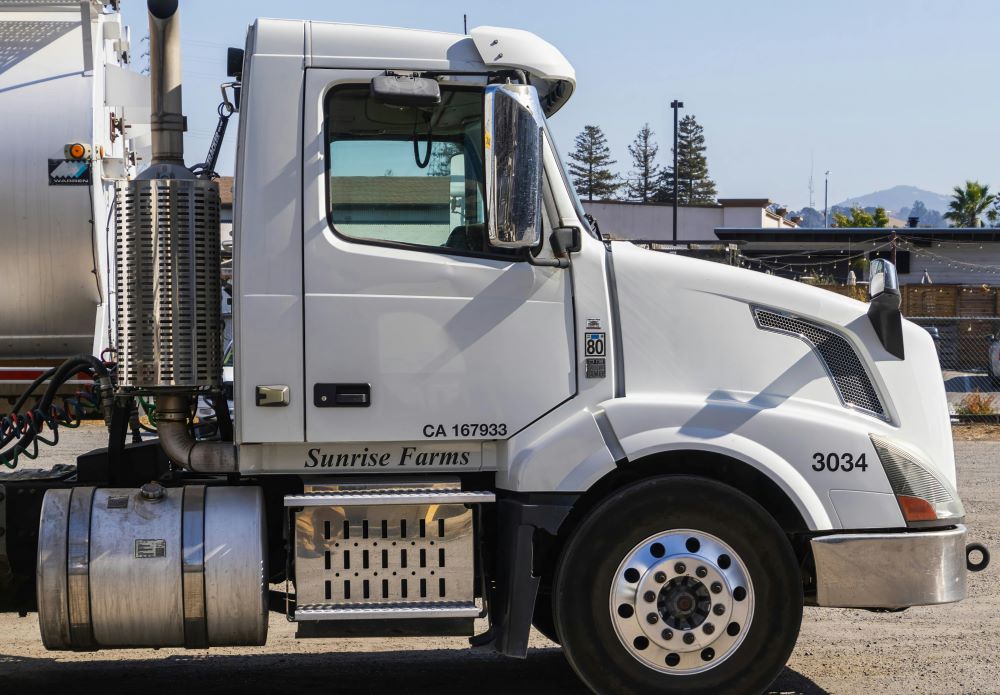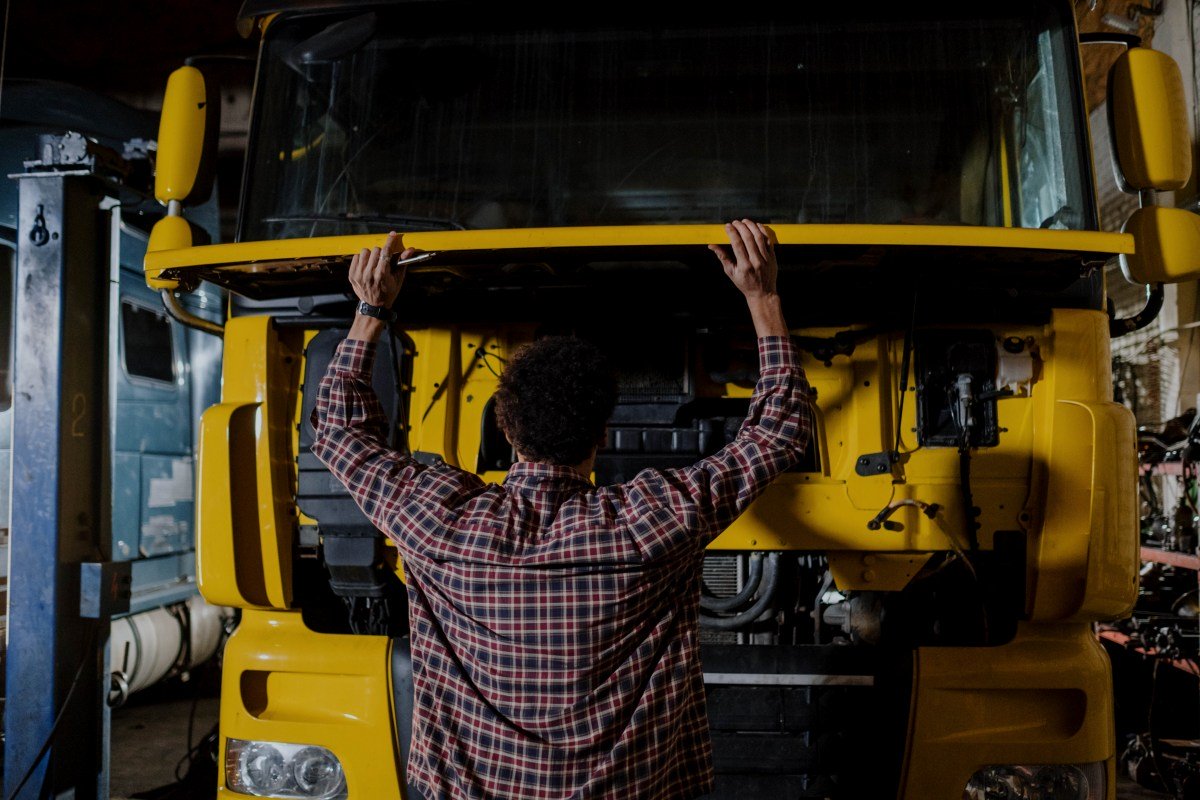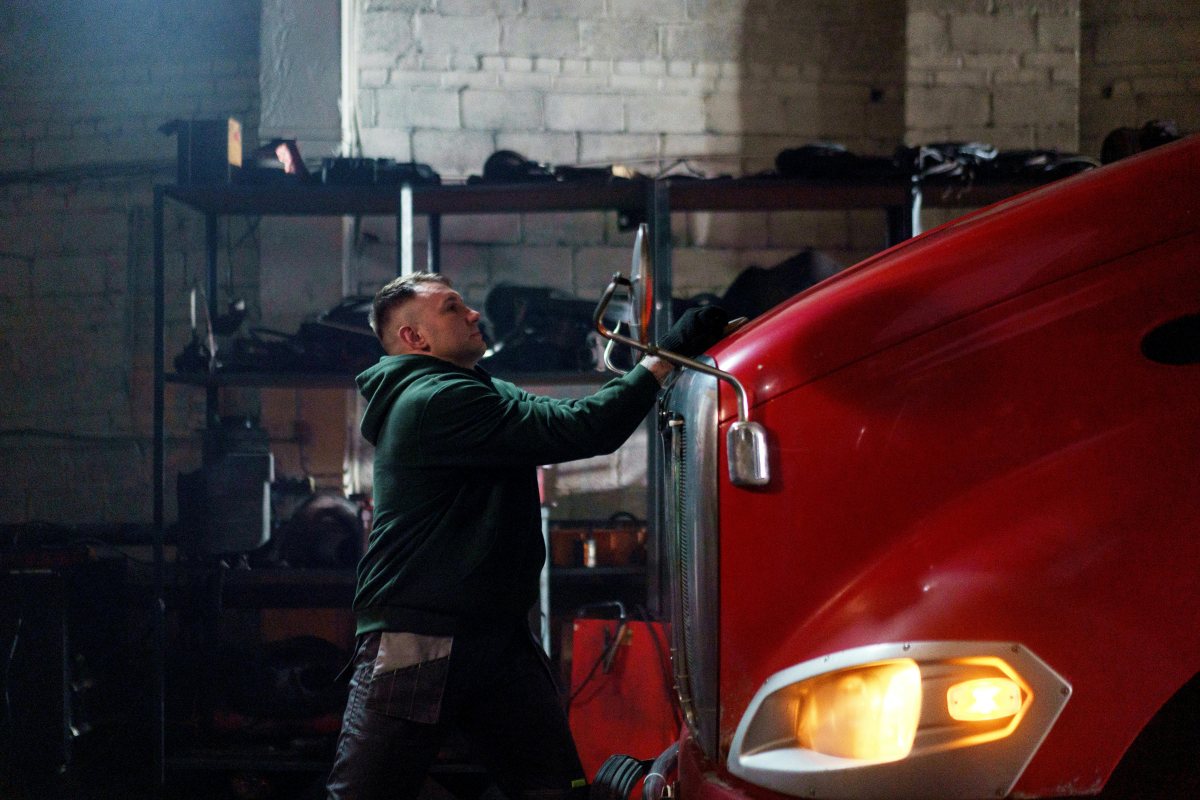
Every mile you drive in your truck adds wear to the parts that keep your truck earning: brakes, tires, belts, and the engine oil that keeps everything moving. Skipping service might save a few hours today, but it almost always costs more later.
A solid truck maintenance checklist is your best defense against downtime. It keeps your commercial truck safe and running at peak performance, no matter what route you take.
That combination of savings and peace of mind is what separates growing operators from everyone else. Now, let’s walk through the essential truck maintenance checklist that keeps every system in your rig performing the way it should.
Why Routine Maintenance Matters for Owner-Operators
Routine maintenance keeps semi trucks compliant, efficient, and earning. It ensures every system, from tires to the air brake system, is safe and ready for inspection under FMCSA Part 396.
Every inspection you pass and breakdown you prevent has a measurable impact on profit. A well-maintained truck uses less fuel and stays in service longer. Keeping up with basic maintenance tasks, like monitoring tire pressure and topping off engine oil, protects your margins more than any upgrade ever could.
When those small details are ignored, problems stack up fast.
For example, underinflated tires hurt fuel efficiency. Low brake fluid or worn brake pads reduce stopping power and can trigger an out-of-service violation during a DOT inspection. Even something as simple as a loose belt can shut down your cooling system and cost you a load.
The American Transportation Research Institute (ATRI) reported that the average cost of operating a truck in 2024 was about $2.26 per mile. That figure covers everything – fuel, maintenance, insurance, and driver pay – and gives owner-operators a clear way to estimate the true impact of downtime.
For example, if your truck usually runs 500 miles a day, every day parked could cost you more than $1,100 in lost productivity.
Miss a week due to a preventable repair, and those numbers climb into the thousands. That’s why every fleet manager and motor carrier needs to treat preventive maintenance as both a safety requirement and a financial strategy.
Understanding Preventive Maintenance Schedules
Every truck requires a structured maintenance schedule based on mileage, time intervals, and operating conditions.
A preventive maintenance plan should align with the manufacturer’s recommendations and include key systems: braking, cooling, electrical, hydraulic, and steering.
Below is a simple example:
| Interval | Key Maintenance Tasks | Purpose |
| Daily / Pre-Trip Inspection | Tires, brakes, brake lights, fluids, emergency gear | Safety, compliance, and reliability |
| Weekly | Batteries, filters, couplings, hoses | Prevent leaks and electrical issues |
| Monthly | Oil, alignment, suspension, exhaust | Enhance fuel efficiency and vehicle performance |
| Quarterly / 25,000 mi. | Transmission, air conditioning system, fuel system | Long-haul dependability |
| Annually / 100,000 mi. | Full DOT inspection, diagnostics, emissions | Ensure compliance and longevity |
Your preventive maintenance efforts will vary depending on route type, vehicle class (medium-duty trucks vs. heavy-duty trucks), and environment.
For example, dusty, mountainous, or hot climates accelerate wear on truck parts, especially filters, brakes, and cooling systems. So, if you regularly drive through these conditions, increase inspection frequency and shorten service intervals.
Adapting your maintenance plan to your operating environment helps you prevent premature wear and keep your truck performing reliably year-round.

Daily or Pre-Trip Truck Maintenance Checklist
Daily checks, often called pre-trip inspections, are mandatory under federal law. They’re the most effective way to detect early problems before they escalate into costly repairs or safety violations.
Tires and Wheels
Inspect every tire for proper air pressure or uneven tire wear. Tire blowouts are a common roadside failure among commercial trucks, usually caused by underinflation or poor alignment.
Check tread depth (minimum 4/32 inch on steering tires, 2/32 on others) and look for stones or nails embedded in grooves. Tighten lug nuts if you notice rust trails or vibration.
Proper inflation also improves fuel efficiency and handling, saving thousands annually in fuel and repair costs.
Brake Function and Air Systems
Test both the service brakes (your primary, foot-pedal system) and the parking brakes (the spring-brake system engaged when parked) before departure to confirm proper air pressure and brake response.
The air brake system should build pressure from 85 to 100 PSI within 45 seconds. Slow pressure build-up or audible air leaks indicate compressor or line issues that demand immediate service.
Drain moisture from air tanks daily to prevent freezing and corrosion. For hydraulic or disc systems, inspect brake pads and rotors for visible wear.
Lighting and Electrical Components
Test brake lights, headlights, turn signals, and clearance markers. Clean lenses with a microfiber cloth and replace dim bulbs immediately.
Next, inspect battery terminals for corrosion and ensure electrical components such as horns and wipers are functioning correctly.
Fluids and Leaks
Check engine oil, brake fluid, power steering fluid, and coolant levels daily. Dirty or milky oil suggests contamination and requires immediate attention.
You also need to inspect under the cab for drips. Even minor coolant leaks can escalate quickly and damage your cooling system or engine belts.
Safety and Emergency Equipment
Confirm that your fire extinguisher is charged and mounted, and that reflective triangles are accessible.
Verify the presence of spare fuses and a flashlight.
These small checks help you stay compliant and safe during roadside emergencies.

Weekly Truck Maintenance Checklist
Weekly maintenance checks catch wear that builds slowly, i.e., the issues you won’t always notice until they affect vehicle performance or driver comfort.
Building them into your preventive maintenance schedule keeps your truck in service and your maintenance costs predictable.
Battery and Electrical Systems
Your truck’s electrical systems power everything from lights to the air conditioning system, so a weak battery can cause more than just slow starts.
Once a week, inspect battery terminals for corrosion and clean them with a wire brush. Apply dielectric grease to keep moisture and oxidation away.
Use a multimeter to check voltage: around 12.6 volts when off and 13.7–14.7 volts while running. Readings outside that range could point to a weak alternator, parasitic draw, or grounding problem.
Don’t ignore dim lights or slow cranking – those are early warning signs of electrical failure.
Air and Cabin Filters
Restricted airflow is a very common and preventable cause of lost fuel efficiency. Dirty air filters make the engine work harder, cutting MPG and raising emissions.
Replace the engine filter every 15,000 to 25,000 miles, or sooner if you haul dusty or off-pavement routes.
Cabin filters deserve equal attention. A clean filter keeps your HVAC system moving air freely, improving air conditioning performance and keeping the cab comfortable for long hours on the road.
Belts, Hoses, and Fluids
Belts and hoses are the lifelines of your truck’s cooling system and hydraulic systems. Each week, look for cracks, glazing, or frayed edges on belts. Squeeze hoses gently; if they feel soft or spongy, replace them before they burst under pressure.
Tighten loose clamps and top off brake fluid or power steering fluid if levels drop. Consistent checks like these prevent overheating, steering loss, and other costly repairs that start with small leaks.
Trailer and Coupling Systems
Safe hauling starts with secure connections. Inspect your fifth wheel, kingpin, and safety chains to ensure a tight, clean lock. Apply grease to the fifth-wheel plate regularly for smooth operation and to reduce wear.
Don’t overlook wiring and air lines. Corrosion or air leaks in the coupling system can cause braking system malfunctions or lighting failures that lead to DOT inspection violations.
A clean, lubricated connection reduces vibration and protects both the tractor and trailer from unnecessary stress during long runs.

Monthly Truck Maintenance Checklist
Monthly service is your opportunity to reset the truck’s overall condition AND spot gradual wear that quietly drives up repair costs and fuel use.
Engine and Oil System
Your engine depends on clean, high-quality engine oil to protect moving parts and maintain proper operation. Change oil every 15,000–25,000 miles, depending on route conditions, idle time, and load weight. Heavy long-haul work may require shorter intervals.
If possible, send a small oil sample for lab analysis. Elevated metal levels indicate internal wear, while traces of fuel or coolant reveal leaks in injectors or seals.
Replace oil filters at every change, and inspect gaskets for seepage around the pan or filter housing.
Preventing contamination protects pistons, bearings, and valves – the core of every semi truck maintenance checklist.
Brake and Suspension Systems
Your braking system is one of the most inspected components on any commercial truck. Check brake drums, rotors, and brake pads for cracks, glazing, or uneven wear. Listen for squeals or grinding. Both mean it’s time for service.
Verify air brake system pressure and confirm there are no leaks along hoses or fittings.
Next, examine the suspension components. Cracked leaf springs, leaking shocks, or worn bushings affect handling and increase driver fatigue. Poor suspension can also cause uneven tire wear and premature steering issues.
Tire Rotation and Alignment
Tires are among the most expensive wear items in any fleet. Rotating them every 10,000 miles helps distribute wear evenly and extends their lifespan. Use a tread gauge to track tread depth, and pay attention to scalloping or cupping – both signal misalignment or balance issues.
Once rotated, verify the truck’s alignment. A properly aligned truck rolls smoothly, keeps the steering wheel straight, and reduces driver strain. For fleet managers, those savings compound fast across multiple units.

Quarterly or 25,000-Mile Maintenance Checklist
Quarterly service focuses on the high-stress systems that quietly wear down over time. Tackling these systems every 25,000 miles helps prevent small inefficiencies from becoming major repairs.
Transmission and Differential Service
The transmission and differential take more abuse than almost any other components in a drivetrain. Both operate under extreme heat and torque, and both depend on clean, correctly filled fluid to prevent metal-on-metal wear.
Check the transmission fluid and differential oil for color and odor. If either looks dark or smells burnt, oxidation has begun, and the fluid needs to be replaced.
For manual gearboxes, inspect the drain plug and output seals for drips; for automatics, replace filters and gaskets on schedule.
When you replace engine oil, take a minute to check transmission and hydraulic systems too. Maintaining consistent fluid levels prevents overheating and protects gears, pumps, and clutches.
Steering and Suspension Systems
A solid steering system means control and confidence behind the wheel. If the steering wheel feels loose or vibrates on uneven pavement, you may have worn tie-rod ends or failing bushings. Inspect all linkages and check for power steering fluid leaks around hoses or the steering box.
For the suspension, look at the air bags, shocks, and leaf springs. Any leaking shock or cracked spring can throw off ride height, affect alignment, and cause uneven tire wear.
Catching these problems early improves handling and reduces fatigue on long runs – a win for both fleet performance and driver safety.
Fuel and HVAC Systems
A clean fuel system keeps the engine breathing and burning efficiently. Replace fuel filters every 25,000 miles, and drain water separators to prevent corrosion inside injectors. Examine the fuel tank for rust or sediment buildup, especially on older commercial trucks or units that sit idle between loads.
Your air conditioning system deserves attention, too. Confirm that the compressor cycles correctly and that the cab stays cool under load. Warm air or weak airflow usually means low refrigerant or a clogged condenser. Clean the coils and test airflow through the cooling system so drivers stay comfortable and alert on long hauls.

Annual or 100,000-Mile Maintenance Checklist
Annual service is your opportunity to reset the truck for another year of reliable work. It’s also the point where compliance meets long-term cost control. A full maintenance plan built around annual inspections ensures every vehicle stays in line with FMCSA Part 396 and DOT standards.
DOT-Level Inspection Readiness
Federal law under FMCSA 396.17 requires every motor carrier to have each truck inspected at least once every 12 months. These inspections verify that commercial trucks and any intermodal equipment subject to regulation are structurally sound and functioning correctly.
Before scheduling your annual check, review your internal maintenance checklist and make sure every item from prior reports has been addressed.
Keep a digital copy of the inspection certificate inside your ELD or tablet. Inspectors can ask for it during audits, and missing paperwork can result in an out-of-service citation.
Major System Replacements
Annual service focuses on replacements rather than tune-ups.
Drain and refill the cooling system and hydraulic systems with OEM-approved fluids. Swap out engine belts and hoses. Rubber and fluid degrade over time, even if the truck hasn’t logged heavy miles.
Check the exhaust system for cracks, loose clamps, or soot trails around gaskets that signal leaks.
Inspect electrical systems and wiring harnesses for corrosion, especially on fleet maintenance operations that run through salt or humidity.
Emissions and Diagnostic Testing
Modern commercial vehicles rely on electronic control modules (ECMs) to monitor every system, from the fuel system to the air conditioning system.
Run a diagnostic scan at least once a year, even if no lights are on, to catch hidden codes early.
Pay attention to sensors tied to the braking, cooling, and exhaust systems. Failing sensors can create false alarms or mask real problems.
Replace any components showing erratic readings to preserve vehicle health and avoid costly repairs later.
Final Thoughts: Building a Reliable Maintenance Culture
Successful truck drivers and fleet managers know that regular maintenance is an investment in their business uptime and general safety.
By performing these maintenance tasks on schedule (checking tire pressure, testing air brake systems, changing engine oil, monitoring the air conditioning system, etc.), you reduce repair costs and prevent breakdowns before they happen.
Keeping your trucks in top condition takes planning and money. When a major repair or replacement catches you off guard, Mission Financial Services can help you cover the costs without missing a load.
Start your credit application today for fast, flexible truck financing and grow your trucking business.


